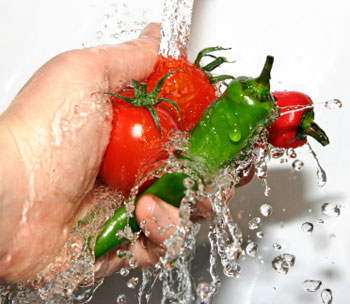It was a long-standing joke in my family that when you took something out of the fridge you checked the expiration date. Many items went in the trashcan and my mother would be upset that food was wasted. Growing up during the Great Depression, my mother was reluctant to waste anything.
 Foodborne illnesses are a serious public health threat that affects millions of Americans each year. The Center for Disease Control and Prevention (CDC) estimates that 1 in 6 Americans (or 48 million people) will get sick from a food-borne illness, 128,000 will be hospitalized, and 3,000 will die.
Foodborne illnesses are a serious public health threat that affects millions of Americans each year. The Center for Disease Control and Prevention (CDC) estimates that 1 in 6 Americans (or 48 million people) will get sick from a food-borne illness, 128,000 will be hospitalized, and 3,000 will die. The older adult is at a greater risk for serious complications or death from a food-borne illness. Why? As we age the effectiveness of our immune systems declines. Our system is slower to respond and takes longer to heal. Combine aging with chronic illness and the risk is increased.
To reduce the risk of food-borne illness in home food preparation, follow the steps below.

- Always wash hands for at least twenty seconds with soap and running water before and after handling food.
- Wash surfaces and utensils after each use.
- Never put raw meat, poultry, or seafood on the same plate or cutting board as vegetables.
- Store raw meat, poultry, or seafood on the bottom shelf of the refrigerator to keep juices from dripping on other food.
- Use a thermometer to check the internal temperature of cooked food. Always cook food to the proper temperature.
- Always thaw food in the refrigerator, never on the countertop.
- Refrigerate prepared foods and leftovers within two hours. Do not leave food on the countertop.
- Wash all fresh produce but not meat, poultry or eggs. Even if you intend to peel the produce, wash first or you can spread bacteria from the outside to the inside.
- Reheat leftovers to 165 degrees.
- Check the use-by or expiration date on all products.
- Never eat food containing uncooked eggs.
At “Your Gateway to Federal Food Safety Information” there are four easy to remember steps to safe food preparation. The steps are CSCC or Clean, Separate, Cook and Chill. There are detailed directions for each step as well as videos at the web site.
Unfortunately, change sometimes occurs only after a frightening incident. Years ago, after a holiday meal, several family members were treated in the hospital for a foodborne illness. The freshness and handling of food in the family is no longer a source of amusement.
More resources!






Leave A Comment
You must be logged in to post a comment.